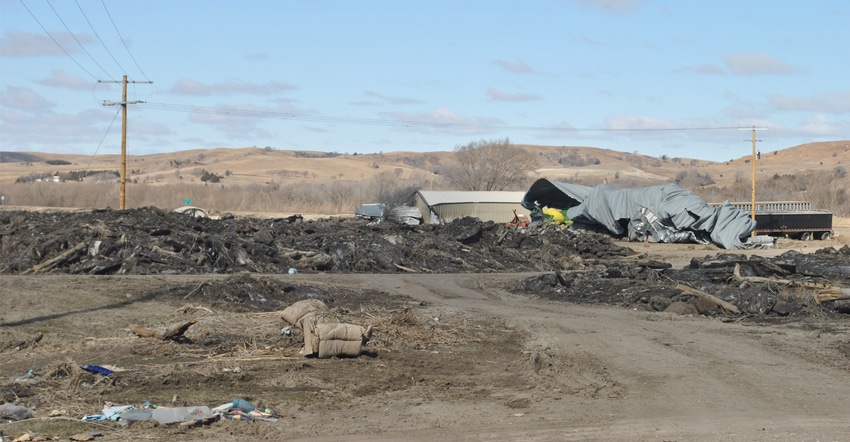
The floods that struck farms across Nebraska and several neighboring states in mid-March were historic in many ways.
Farms that had been established more than a century ago along many of the flooded waterways had never experienced water or ice damage like they did this spring. Unfortunately, when flood victims called their insurance agents to check on coverage, many were disappointed to find out that they were not covered.
Ryan Loecker, Town and Country Insurance, has insurance customers across Knox, Boyd and Cedar counties in northeast Nebraska, where much of the flooding was centered. He first visited several of his customers in Knox and Boyd counties, along the Niobrara River basin and its tributaries, only a few days after floodwaters had started to recede.
“The devastation was just heartbreaking,” Loecker says. “It was almost too much for some of the farmers to talk about.”

DEVASTATING LOSSES: “The devastation was just heartbreaking,” Ryan Loecker, Town and Country Insurance, says about flood losses in Knox, Boyd and Cedar counties, where he has customers who were struck by flooding in mid-March. “It was almost too much for some of the farmers to talk about.”

After the flooding, not only was everything devastated, but farmers and ranchers struggled to inventory what they had lost.
“Farmers may have lost several cows but hadn’t been able to get to their cows for several days because of the flooding,” Loecker says. “They were maybe calving at the time, so they didn’t know which cows had been swept away and which ones had calves during the flooding.”
It was a horrific experience for those farm families. Loecker also heard stories of heroics from his customers, including harrowing rescue attempts between neighbors that were made in the dark of night during the worst of the flooding.
Insurance coverage from floods on the farm is a mixed bag, with some aspects of the farm easily covered, and other major components that need special attention to be covered for floods.
Nebraska Farmer sat down with Loecker to go over flood coverage in depth. Here are some of the most important messages for producers:
Farm machinery. Farm machinery, including large equipment such as tractors and combines and smaller pieces such as mowers and implements, can be covered from flooding under a farm blanket insurance policy if you have a special risk endorsement on the machinery, Loecker says.
“The farm blanket policy covers damages from fire, wind, hail, theft and water, when it comes to machinery, if the special risk endorsement has been purchased,” he says. “That special risk coverage might cost another 20% to 40% premium on top of the regular blanket.”
Depending on the deductible of the machinery, the insurer may choose to total out an older tractor worth $5,000 for instance, rather than pay for repairs. On a new tractor worth tens of thousands of dollars, it is cheaper for the insurer to pay for an engine overhaul, he says.
Damages depend on how high the water was on the tractor or combine and how long it was in the water, and if there were other damages. Implements, such as disks, generally would not incur damages from floodwater unless those damages came from debris and ice or the implement was moved by the water and damaged.
In any case, Loecker says that with a special risk endorsement, insurance would cover losses or repairs after the deductible is met on machinery.
In settling claims on machinery, insurance adjustors will call local farm machinery dealers or repair shops to discover the local value of the machinery, or to find the value of repairs to the pieces that are claimed, Loecker says.
Center pivots. Like machinery, center pivots also are covered under the farm policy from perils that include flooding. Pivots automatically are insured with special risk coverage that includes floods. Loecker says that irrigation pumps and diesel engines, for instance, also would be covered with the pivot. Fuel tanks probably would be covered, but the fuel inside the tank may not.
Farm vehicles. You will need to have comprehensive vehicle coverage on your farm trucks or vehicles to be covered from flood losses, Loecker says. Any amount of water that reaches the engine and vehicle interior will most likely result in totaling that vehicle.
Livestock. Livestock losses because of flooding and drowning are covered by farm insurance. The adjuster will need to know the number of head and weight of the stock at the time of the loss. They will call the local livestock market or packer to discover the value of the stock lost. Loecker says that pregnant cows are worth more than open heifers, so insurance will value your lost livestock accordingly.
Grain, hay and forages. Grain, hay and forages that were soaked with water and debris during flooding or washed away from floodwaters are not covered by the farm policy. Even hay that is unusable because of floodwaters is not covered.
“You’ll see hay bales that were half submerged in floodwater, so the bottom half is completely ruined, but the top half is still OK,” Loecker says. “In this case, you still wouldn’t receive any coverage on that hay. Your best option might be to try to feed the top half of the bales somehow and dispose of the bottom half to salvage at least some of the forages.”
Farm buildings, structures and grain bins. Grain bins, farm structures and buildings typically are not covered by farm blanket policies because of the flood exclusion, unless farmers have bought flood insurance on those structures, Loecker explains.
Farmers living and operating in some rural counties do not have the option to buy flood insurance, even if they wanted to, because the rural parts of the county are not zoned for flooding. However, Knox County is zoned, so landowners and homeowners can opt in for flood insurance coverage. In the floodplain, that could cost as much as five or six times the regular premiums. Even with a high deductible, this can be a costly annual expense, Loecker acknowledges.
However, if the insurance coverage rebuilds major farm structures and a farm home once in the lifetime of the farmer, that may be enough to make it worthwhile, he says. If the premium is $2,000 per year, as an example, it would cost $40,000 over a 20-year period to insure. However, if the insurance kicked in during a flood event, that coverage would pay for itself.
Farm dwelling. Like the farm buildings, the farmhouse is generally not covered for floods or water in the basement unless special flood insurance is purchased. If the home is tiled around the foundation and is equipped with a sump pump to remove excess water, seepage into the basement during flood events may be covered if the sump pump is malfunctioning or is unable to keep up with the excess water, Loecker says.
If you have a flood claim or a claim for any disaster, Loecker says photos of inventories, records and journals that include numbers, along with calving or livestock inventory sheets or books, all are useful in filing a claim.
He notes that items that are not covered for flooding by insurance may be eligible for assistance through the Federal Emergency Management Agency. Loecker says his explanations are for information purposes only and are not a substitute for a private consultation with a farmer’s own insurance professional.
There may be some varied differences in coverage from state to state. Be sure to discuss your own operational insurance needs with your local agent regarding flood insurance coverage or filing claims after floods, Loecker says.
About the Author(s)
You May Also Like






